Interfacial flow, or the two-phase flow where an interface separates two immiscible phases, is omnipresent in various industrial and environmental processes. Examples include liquid atomization, oil extraction, continuous casting and sloshing waves. Numerical modelling of such flows is essential for many applications especially when turbulence steps in.
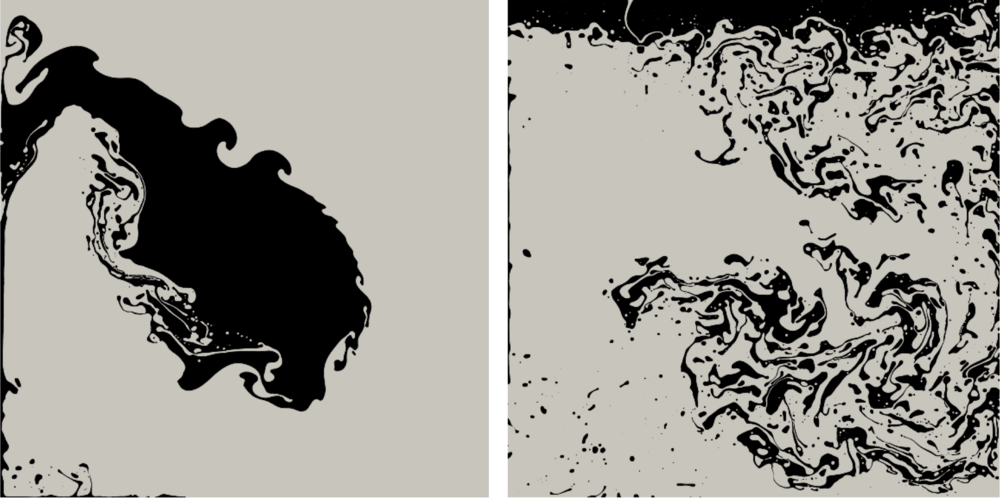 Figure 1: High resolution VOF simulation of a phase inversion benchmark
test (representing e.g. oil rising to water surface); such benchmarks serve as
validation base for the development of novel multiphase LES models, which are
needed for modelling interfacial flows for e.g. liquid metal/slag processes.
Figure 1: High resolution VOF simulation of a phase inversion benchmark
test (representing e.g. oil rising to water surface); such benchmarks serve as
validation base for the development of novel multiphase LES models, which are
needed for modelling interfacial flows for e.g. liquid metal/slag processes.
Whereas Large Eddy Simulation (LES) of single-phase flows is already widely used in the CFD world, even for industrial applications, LES of two-phase interfacial flows, i.e. two-phase flows where an interface separates two immiscible fluids (liquid or gas phases), still remains a challenging task. The main issue is the development of subgrid scale models well suited for two-phase interfacial flows.
Introducing spatial filtering to the governing equations of the interfacial flows results in appearing various subgrid terms that should be modelled via subgrid closures. Whereas the well-known subgrid contribution of the non-linear convective term is modelled using eddy-viscosity approach (e.g. Smagorinsky model for example), the other sub-grid terms such as the contribution of surface tension force and transport of interface are usually neglected in the current state of the art of LES of two-phase flows. According to a priori studies [1], these terms are not always negligible and their contribution can be of great importance especially when the viscosity and the density ratio of two fluids are close to unity (e.g. water-oil systems).
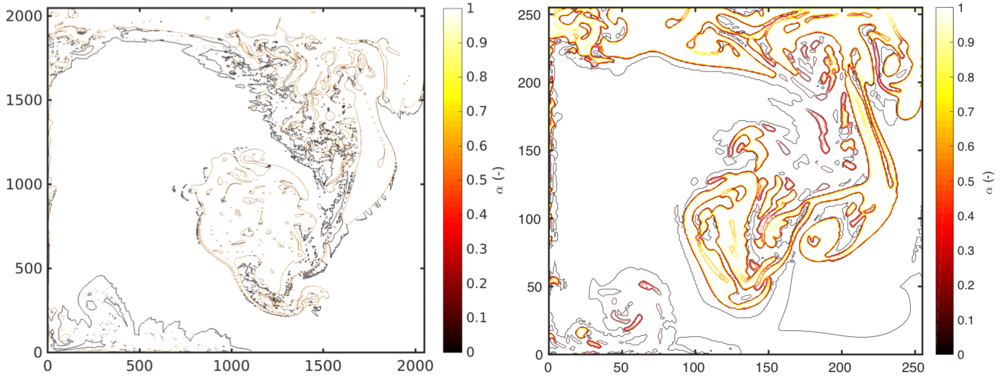 Figure 2: Snapshot of interface profiles of quasi-direct numerical simulation of interfacial turbulence in the oil-water phase
inversion process (left) and a-posteriori LES using ADM on 8 times coarser grid (right) at the peak of enstrophy.
Figure 2: Snapshot of interface profiles of quasi-direct numerical simulation of interfacial turbulence in the oil-water phase
inversion process (left) and a-posteriori LES using ADM on 8 times coarser grid (right) at the peak of enstrophy.
A recent a-priori study [2] also presented a comparison study between different sub-grid closure models in the literature. It is clearly concluded that the subgrid model of Approximate Deconvolution Model (ADM) [3] shows the best performance to predict the sub-grid contribution of those terms. ADM is a structural subgrid modelling with a purely mathematical nature. Since no prior knowledge of the physics of the interaction between resolved and non-resolved scales is needed, ADM seems a potential candidate for developing subgrid closure for LES of two-phase flows [4].
Currently, we are working on the a posteriori large eddy simulation of interfacial flows on the phase inversion benchmark (Figure 1) by including all the subgrid contributions modelled by the structural model of ADM (Figure 2). In this research, we also benefit from close collaboration with the group of Prof. Stéphane Vincent at the University of Paris-Est Marne La Vallée (UPEM), France.
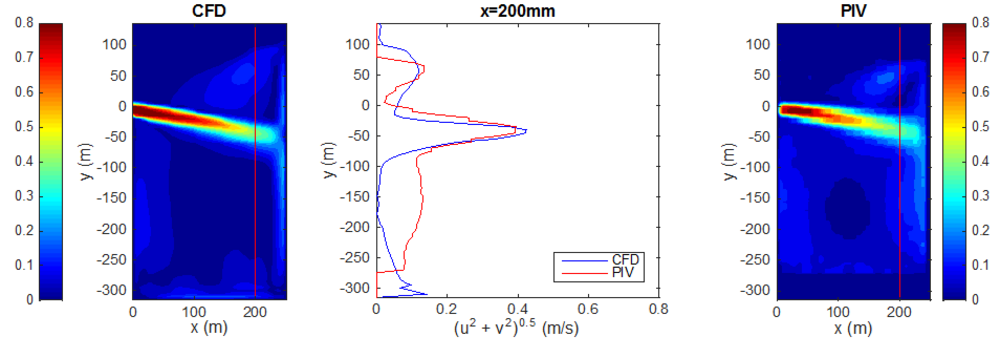 Figure 3: Comparison of CFD simulation results (left) with PIV measurement (right) for the flow rate of 0.26 (lit/s) and inlet configuration of -10°. The averaged velocity at the x=200 mm from the inlet is also plotted in the middle sub-figure.
Figure 3: Comparison of CFD simulation results (left) with PIV measurement (right) for the flow rate of 0.26 (lit/s) and inlet configuration of -10°. The averaged velocity at the x=200 mm from the inlet is also plotted in the middle sub-figure.
One of the industrial applications of such two-phase LES models is modelling turbulence-interface interaction in the continuous casting mold flow. This interaction may be the major reason for slag entrainment. Recently, we investigated the global behavior of turbulent molten metal-slag interfacial flow both numerically (LES-VOF) and experimentally (PIV). A promising agreement is revealed on the macroscopic flow characteristics such as velocity fields and interface displacement [5]. The average velocity fields in the mold are compared in Figure 3. Besides, the maximum slag entrainment depth for different nozzle injection angles corresponds quite well between CFD and experimental results (Figure 4). We expect that the improvement through our new subgrid modelling of interfacial flow will improve our understanding on such complex interfacial turbulent flow, and gives a better picture on the mass transfer along with the interfaces in continuous casting process.
 Figure 4: The mold flow experiment showing the position of maximum slag layer entrainment (right),
and the comparison of maximum slag entrainment positions
during the simulation and experiment at -10° (middle) and 0° (right).
Figure 4: The mold flow experiment showing the position of maximum slag layer entrainment (right),
and the comparison of maximum slag entrainment positions
during the simulation and experiment at -10° (middle) and 0° (right).
References:
[1] Vincent, S. et al. Numerical simulation of phase separation and a priori two-phase LES filtering, Computers & Fluids 37, 898–906, 2008.#
[2] Vincent, S. et al. A priori filtering and LES modeling of turbulent two-phase flows Application to phase separation. Computers & Fluids, 2016, in press.
[3] Stolz, S. and Adams, N. A., An approximate deconvolution procedure for large-eddy simulation, Physics of Fluids 11, 1699–1701, 1999.
[4] Schneiderbauer, S. and Saeedipour, M., Approximate deconvolution model for the simulation of turbulent gas-solid flows: An a priori analysis, Physics of Fluids 30, 23301 (2018).
[5] Saeedipour, M., Puttinger, S., Pirker, S., LES-VOF simulation of turbulent interfacial flow in the continuous casting mold, 12th International Conference on CFD in Oil Gas, Metallurgical and Process Industries, Trondheim, Norway (2017).
The primary breakup of liquid jets is a major step in many technical and industrial processes, from fuel injection to spray cooling, from ink-jet printing to spray drying and from firefighting systems to medical sprays. However, due to the small length scales involved, which determine the size of generated droplet, a fully resolved numerical simulation of industrial applications is still unfeasible. To overcome this limitation to computational resources, multiscale modelling strategies have been developed in recent years, and are feasible candidates to to model such highly-turbulent multiphase flows.
We proposed a numerical model for the coarse-grid simulation of turbulent liquid jet disintegration and primary atomization is developed based on an Eulerian-Lagrangian coupling [1]. To picture the unresolved droplet formation near the liquid jet interface in the case of coarse grids we considered a theoretical model to describe the unresolved flow instabilities leading to turbulent breakup. The generated droplets are then represented by an Eulerian-Lagrangian hybrid concept (figure 1). On the one hand, we used a volume of fluid method (VOF) to characterize the global spreading and the initiation of droplet formation; one the other hand, Lagrangian droplets are released at the liquid-gas interface according to the theoretical sub-grid model balancing consolidating and disruptive energies. The dynamics of the generated droplets are modelled using Lagrangian particle tracking (LPT). A numerical coupling between the Eulerian and Lagrangian frameworks is then established via source terms in conservation equations.
The presented methodology was tested through sets of validation studies using different test cases and empirical correlations from the literature. Recently, this multiscale modelling approach has been validated against the results of an in-house phase-Doppler anemometry (PDA) experiment [2] (in close collaboration with TU Graz). The droplet properties, such as size distribution, Sauter mean diameter (SMD) and velocity distributions obtained from the simulations are compared with experiment at various streamwise locations with very good agreement. It has to be further noted that this modelling approach reduces the computational expenses and enables modelling the high Reynolds number sprays with reasonable computational costs.
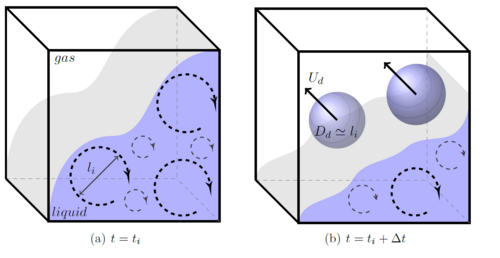 Figure 1: Schematic of subgrid breakup model for Eulerian - Lagrangian coupling in multiscale approach. Droplets are extracted along with the interface.
Figure 1: Schematic of subgrid breakup model for Eulerian - Lagrangian coupling in multiscale approach. Droplets are extracted along with the interface.
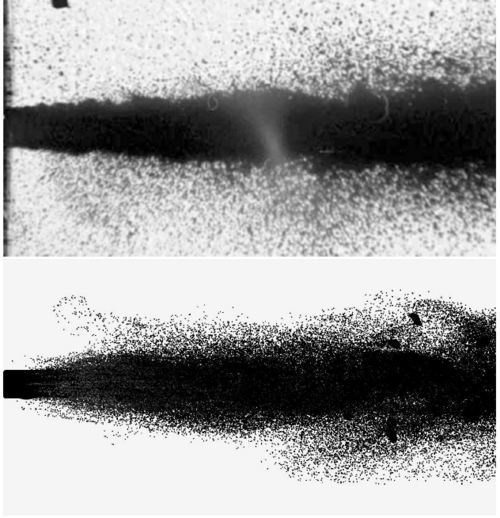 Figure 2: Multiscale simulation results for ethanol jet with Re = 31000 at surrounding pressure P=6 MPa
after 5 ms (bottom) compared with experiments by Mayer and Branam (2004) (top).
Figure 2: Multiscale simulation results for ethanol jet with Re = 31000 at surrounding pressure P=6 MPa
after 5 ms (bottom) compared with experiments by Mayer and Branam (2004) (top).
References:
[1] Saeedipour, M., et al. An Eulerian-Lagrangian hybrid model for the coarse-grid simulation of turbulent liquid jet breakup, International Journal of Multiphase Flow 82, 17-26, (2016).
[2] Saeedipour, M., et al. Multiscale simulations and experiments on water jet atomization, International Journal of Multiphase Flow 95, 71-83, (2017).